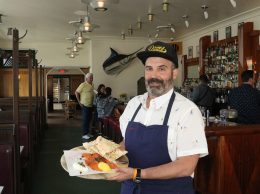Carp flower industry standing strong
Flower growers in Carpinteria, the biggest flower-producing region in the state, are working together to try to keep up as their foreign rivals grow more and more competitive.
California’s multimillion-dollar cut flower industry is being threatened by federal trade policies that provide subsidies to foreign flower growers, particularly those in Bogota, Colombia, according to a news release from Rep. Lois Capps, D-Santa Barbara. But while the number of California flower farms is shrinking rapidly because of federal policies and the stagnant economy, almost all of the growers in Carpinteria are still in business.
“The Central Coast’s flower growers play an important role in our local economy,” said Capps, who spoke at the kick-off event for the annual Carpinteria Greenhouse & Nursery Tour on April 13. “Our local flower growers exemplify the American spirit, working tirelessly to out-think and out-innovate their competitors. I am proud to support these valued local businesses, and their efforts to stay competitive in the global marketplace.”
Kasey Cronquist, CEO of the California Cut Flower Commission, said the flower industry is still a major economic engine for Carpinteria, known in the industry as California’s “flower basket.” He said the public greenhouse tours, to be held on April 14, are good for flower growers because they allow consumers to see where the flowers originate.
“Right now, 85 percent of people don’t know where their flowers come from. What’s been really beneficial to the industry is the local food movement,” Cronquist said. “It makes people want to know where their flowers come from.”
And the local food movement doesn’t seem to be a passing trend, said Cathy Fisher, Santa Barbara County’s agricultural commissioner. “There’s real interest from consumers who want to buy local products,” Fisher said.
One way for growers to encourage the local food movement is by participating in farmer’s markets. When farmers bring products to farmer’s markets, they fill out a certificate detailing where and when the flowers were grown. The concept, Fisher said, is to sell locally-grown flowers to local residents.
June Van Wingerden is the owner of Carpinteria-based OceanBreeze Floral Farms. She said the local food movement is a huge factor that’s enabled so many regional flower farms to survive.
“We feel that we’ve kept Carpinteria the small beach town that it is by competing on a global scale by selling our cut flowers,” she said.
Another way farmers are staying in business is with energy-efficient practices. Many flower growers use natural gas under an incentivized program run by Southern California Gas Co. Ever-Bloom, the flower farm that’s hosting the greenhouse tours, has saved 30 percent on energy costs by using natural gas.
On a national level, Capps is using her role as a state representative to try to convince the White House to buy domestically grown flowers. “Trade agreements have given an unfair advantage to growers outside the U.S. The White House has a flower room in the basement that makes hundreds of bouquets every day,” she said. “They buy domestic food and drink — we really want to push them to buy U.S. flowers.”












